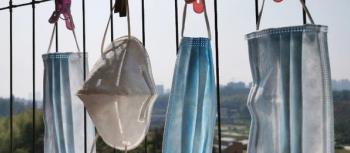
Surgical, Cotton Masks Equally Ineffective in Blocking COVID-19 Spread, Say Investigators
Investigators found greater SARS–CoV-2 contamination on the outer surface of the face masks than on the inner surfaces.
EDITOR'S NOTE: The study upon which this article was based has since been retracted by the Annals of Internal Medicine. Here is the
Surgical and cotton masks are both ineffective when it comes to blocking droplets of the virus SARS–CoV-2 that may be generated when somebody coughs, according to investigators with the Ulsan College of Medicine, Seoul, South Korea. Their
“The median viral loads after coughs without a mask, with a surgical mask, and with a cotton mask were 2.56 log copies/mL, 2.42 log copies/mL, and 1.85 log copies/mL, respectively,” the research letter states. “All swabs from the outer mask surfaces of the masks were positive for SARS–CoV-2, whereas most swabs from the inner mask surfaces were negative.”
The study did not include the N95 masks, which are in short supply these days and which infection preventionists and other healthcare workers
The masks were swabbed with Dacron swabs; the outer and inner surfaces of both the surgical and cotton masks. The researchers found SARS COV-2 on all surfaces.
The results come after the US Centers for Disease Control and Prevention (CDC) recently said that people should wear
The research letter investigators found greater contamination on the outer surface of the face masks than on the inner surfaces.
“Although it is possible that virus particles may cross from the inner to the outer surface because of the physical pressure of swabbing, we swabbed the outer surface before the inner surface,” the research letter states. “The consistent finding of virus on the outer mask surface is unlikely to have been caused by experimental error or artifact.”
It’s possible that the aerodynamic properties of the masks may account for this. “A turbulent jet due to air leakage around the mask edge could contaminate the outer surface,” the research letter states. “Alternatively, the small aerosols of SARS–CoV-2 generated during a high-velocity cough might penetrate the masks.”
However, the investigators say that this hypothesis works only if the coughing patient didn’t exhale large-sized SARS–CoV-2 particles. They’d be trapped in the inner mask even with a high-velocity cough.
“These observations support the importance of hand hygiene after touching the outer surface of masks,” investigators conclude.
Newsletter
Stay prepared and protected with Infection Control Today's newsletter, delivering essential updates, best practices, and expert insights for infection preventionists.





